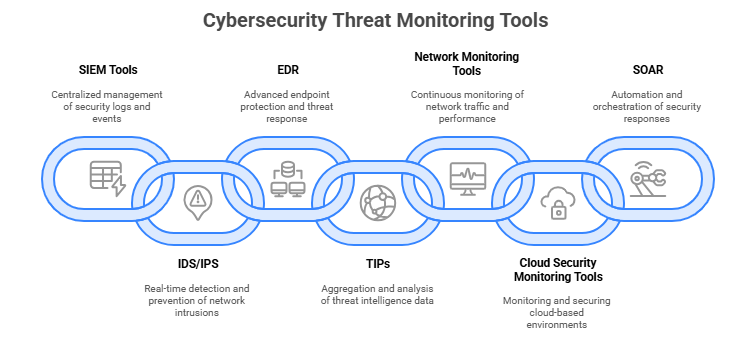Cybersecurity Threat Monitoring Tools
The cybersecurity landscape is always evolving as new threats and attack methods emerge. As threats evolve, organizations should utilize cybersecurity threat monitoring tools to detect, investigate, and respond to threats in real time. There are many types of tools and platforms on the market, which can be overwhelming for businesses looking for the best solution.
This article will break down the different tools available for continuous monitoring of cybersecurity threats.

Security Information and Event Management (SIEM) Tools
SIEM platforms aggregate logs and security data from across the IT environment, including firewalls, servers, applications, and endpoints. With the embedding of AI functionality, they analyze patterns, trigger alerts for suspicious activity, and assist organizations in not only quickly responding to cybersecurity threats but also in understanding and preventing future incidents. SIEMs serve as the backbone of monitoring by providing security teams with a centralized view of potential threats, and dashboards for compliance reporting.
Popular SIEM platforms include Splunk, IBM QRadar, and Microsoft Sentinel.
Common SIEM uses include:
- Configuring log forwarding from all critical systems (e.g., Windows Event Logs, firewall logs).
- Building custom correlation rules for your environment, such as repeated failed logins or privilege escalations.
- Setting up dashboards for compliance requirements like PCI DSS or HIPAA.
Intrusion Detection and Prevention Systems (IDS/IPS)
Intrusion Detection and Prevention Systems monitor network traffic for known attack signatures and unusual behaviors. IDS/IPS solutions help detect intrusions in progress and can even block malicious traffic in real time, adding a critical layer of defense.
Intrusion Detection and Prevention Systems providers include Snort, Suricata, and Cisco Firepower.
Common uses include:
- Deploy IDS sensors at network choke points (internet gateways, between segments).
- Regularly update signature databases to detect new threats.
- Tune rules to reduce false positives, focus first on critical assets like databases and domain controllers.
Endpoint Detection and Response (EDR)
Endpoints are common attack targets, making Endpoint Detection and Response platforms vital. These tools provide continuous visibility into endpoint activity to detect suspicious behavior like ransomware and malware activity and enable rapid investigation and remediation.
Popular EDR platforms include CrowdStrike Falcon, SentinelOne, and Microsoft Defender for Endpoint.
Valuable EDR platform functions include:
- Install lightweight agents on all workstations and servers.
- Use behavioral detection (not just signatures) to catch fileless malware.
- Automate quarantines and isolate infected machines to contain outbreaks quickly.
Threat Intelligence Platforms (TIPs)
Threat Intelligence Platforms bolster security operations by providing context about new and emerging threats. TIPs aggregate external threat feeds (IP addresses, domains, malware hashes) and integrate them into monitoring tools, helping organizations proactively defend against new attack methods.
Prevalent TIPs include Recorded Future, ThreatConnect, and Anomali.
To effectively use Threat Intelligence Platforms, organizations should:
- Subscribe to both commercial and open-source threat feeds.
- Correlate threat intel with your own logs to detect known malicious infrastructure.
- Prioritize intelligence relevant to your industry.
Network Monitoring Tools
Network monitoring tools provide real-time insight into network performance and anomalies, enabling the detection of unusual patterns such as data exfiltration attempts or lateral movement across systems.
Examples of network monitoring tools include Zeek, Nagios, and SolarWinds.
Businesses can use network monitoring tools to:
- Execute deep packet inspections and long-term traffic analysis.
- Detect unusual outbound connections.
- Configure alerts for abnormal bandwidth spikes or connections to suspicious geographies.
Cloud Security Monitoring Tools
Businesses that leverage cloud services are adding an extra layer of risk, creating the need for cloud security monitoring tools. These tools continuously monitor workloads and cloud-native applications to identify misconfigurations, suspicious access patterns, and compliance risks unique to cloud environments.
Popular cloud security monitoring tools include AWS GuardDuty, Google Security Operations (formerly known as Chronicle), and Palo Alto Prisma Cloud.
Cloud security monitoring tools can be used to:
- Monitor for suspicious activities, indicate compromise, and malicious behaviors, enable faster detection and automated or manual response to security incidents.
- Continuously scan cloud infrastructure for misconfigurations, missing patches, and other vulnerabilities.
- Integrate findings into SIEM for centralized visibility.
Security Orchestration, Automation, and Response (SOAR)
Security Orchestration, Automation, and Response platforms automate response actions such as blocking malicious IPs or disabling compromised accounts to streamline workflows. SOAR platforms can sync with SIEM and EDR tools to reduce the burden on security teams and enable faster remediation.
Cortex XSOAR and Splunk SOAR are examples of SOAR platforms.
SOAR platforms can be used to:
- Build playbooks that define automated response actions (e.g., when SIEM flags an IOC, automatically update firewall rules).
- Test workflows in a controlled environment before enabling auto-remediation.
- Integrate with ticketing systems (ServiceNow, Jira, etc.) to track response efforts.
No single tool can provide complete protection, which is why organizations typically use a layered monitoring strategy. CompliancePoint has a team of cybersecurity experts who can help you craft a monitoring strategy that fits your organization’s needs. To learn more about our cybersecurity services, reach out to us at connect@compliancepoint.com.
Finding a credible expert with the appropriate background, expertise, and credentials can be difficult. CompliancePoint is here to help.





